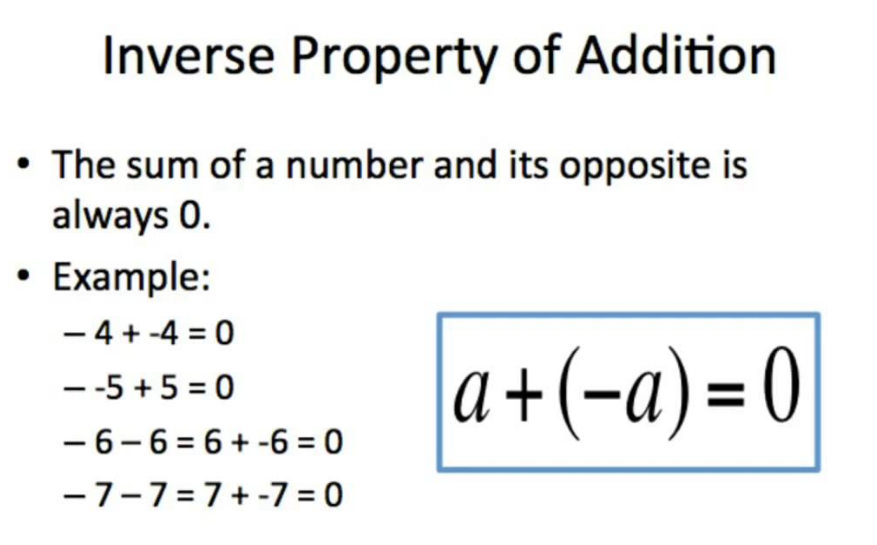Inverse Property of Addition is what number you add to a provided number to make the sum zero. For instance, if we take the number 3 and add -3 to it, the result is zero. Therefore, the additive inverse of 3 is -3.
We come across such positions in our daily life where we nullify the value of a quantity by taking its additive inverse. A fair amount of fire and ice will cancel out each other and the result will be zero. Let us see the additive inverse property of real and complex numbers.
Table of Contents
What is Additive Inverse?
The additive inverse of a number is its reverse number. If a number is figured to its additive inverse, the sum of both the numbers becomes zero. The mere rule is to change the positive number to a negative number and vice versa. 7+ (-7) =0. So -7 is the additive inverse of 7 and 7 is the additive inverse of -7.
Inverse Property of Addition
When the sum of two real numbers is zero, then every real number is said to be the additive inverse of the other. R+(-R) = 0, wherever R is a Real number. R and -R are the additive inverses of all other. For example: ¾+ (-¾) = 0. Hither ¾ is the additive inverse of -¾and -¾ is the additive inverse of ¾.
Let’s suppose you have a bucket of water at room temperature. You add a liter of hot water to it which makes the overall temperature of the bucket rise by a particular amount. Now, add different liters of cold water to it. The different temperatures of water added to the bucket will cancel out each other, and the result will be a bucket of water at room temperature. The corresponding rule applies while finding the additive inverse of a number. The additive inverse property holds great for both real numbers and complex numbers.

Additive Inverse of Complex Numbers
The algebraic property of complex numbers states the presence of additive inverse. Given each complex number z ∈ C, there is a unique complex number, denoted by −z, such that z+ (−z)=0. Moreover, if z = (x,y) with x,y ∈ R, then −z = (−x,−y).
Let Z = x + iy be the given complex number. Then its inverse is -Z = -x-iy. For instance, the additive inverse of -i-1 = -(-i-1) = i +1
Additive Inverse Formula
The general formula for the additive inverse of a number can be provided in the form of the number itself. Any number when added to its negative will cancel out all others and give the overall sum as zero. We need to find the negative of that given number N. In other words, we need to find –1 × (N). Hence, we can say that :
Additive Inverse of N = –1 × (N)
Additive Inverse in Algebraic Expressions
The property of additive inverse terms can be increased to algebraic expressions. Following the same rule as stated earlier, the additive inverse of an algebraic inverse is one that makes the sum of all the terms zero. Note: The additive inverse of the expression is -(expression). The additive inverse of x2 + 1 is – (x2 + 1) = -x2 – 1.
For instance, Jimmy had two apples and three peaches. The total number of apples and peaches he had can be expressed as 2x + 3y, where ‘x’ represents the apples and ‘y’ represents the peaches. He shared the fruits among his five other friends. Now, the expression can be written as: – x – x – y – y – y, which explains how all the fruits he had been distributed or given away. Accordingly, the additive inverse of 2x + 3y is -2x – 3y, making the sum of all the elements zero.
FAQs
How Do You See The Additive Inverse of a Given Number?
Just change the sign of the given number and we see its additive inverse. For instance, the additive inverse of 8 is -8. The additive inverse of 1/8 is -1/8. The additive inverse of -35 is 35.
What is the Additive Inverse Formula?
The additive inverse formula is -1 × R, where R is any real number.
What is the Additive Inverse of zero?
Since zero does not have a positive or negative sign connected with it, the additive inverse of zero is zero.
Is Additive Inverse Same as Additive Identity?
No, additive inverse and the additive identity are not the same. The additive inverse of a given number is known by just reversing its sign. Commonly the given number and its additive inverse give 0. Whereas, the additive identity of any given number is 0, as the addition of the given number and zero gives the same number.
The additive inverse of 4 is -4.( 4 – 4 = 0)
The additive identity of 4 is 0. (4 + 0 = 4)
